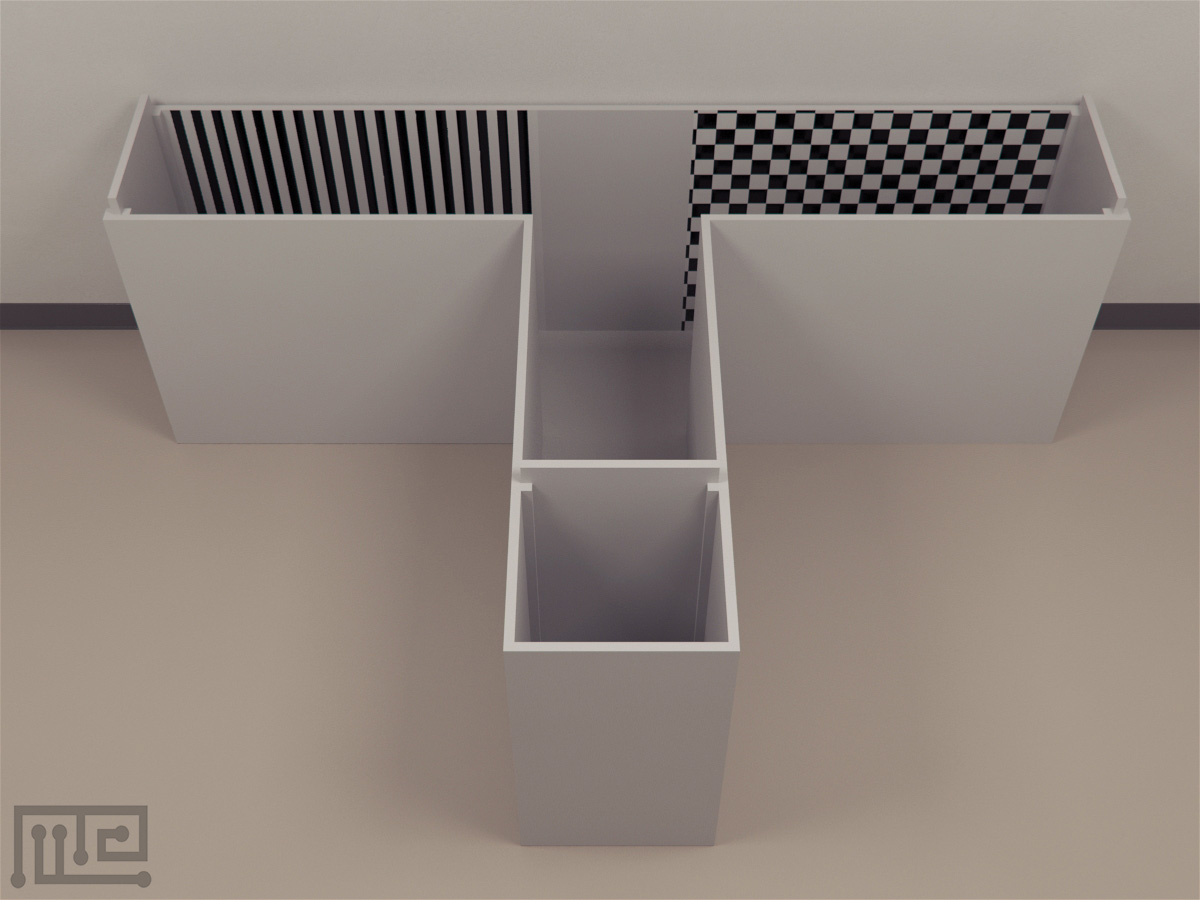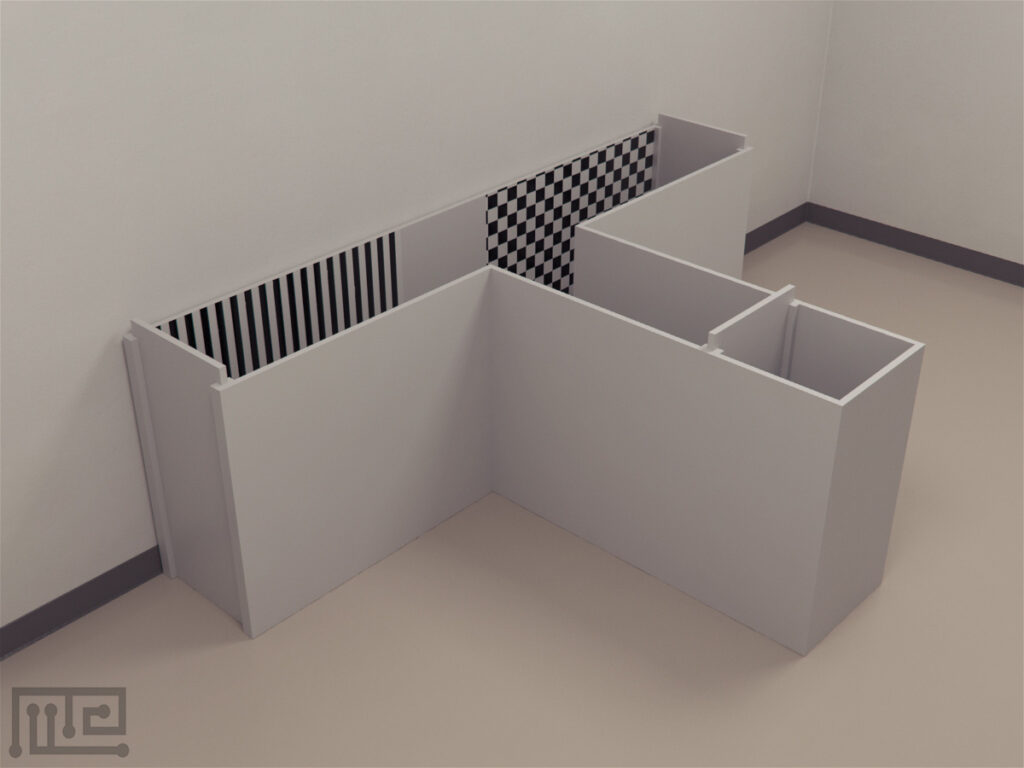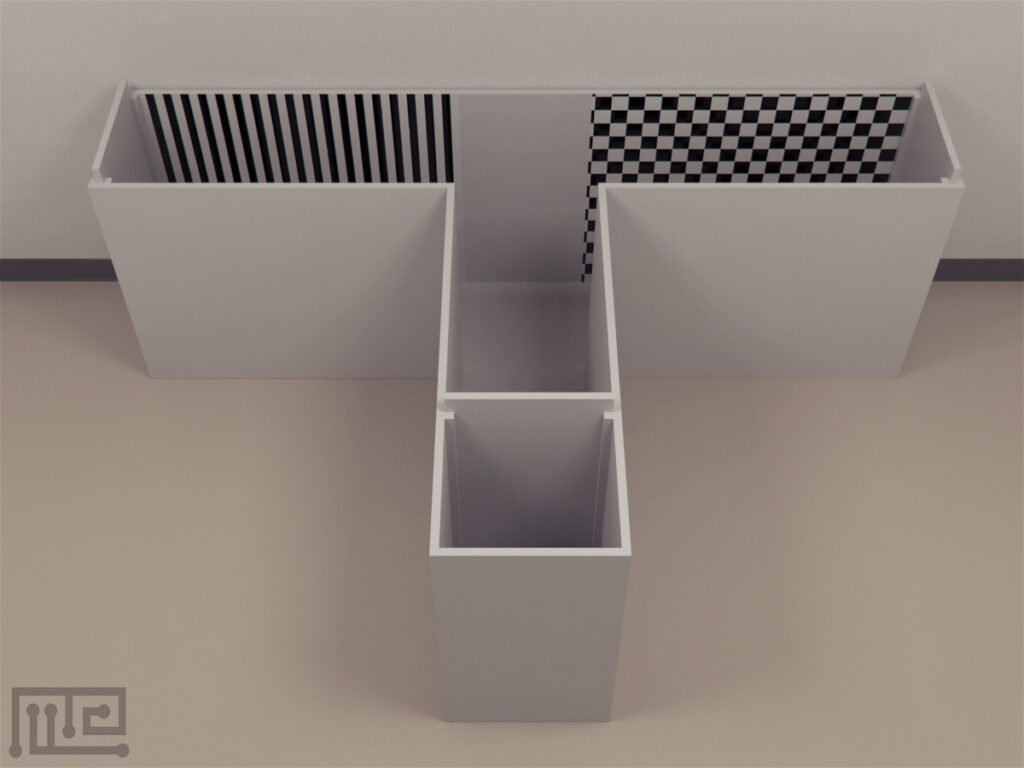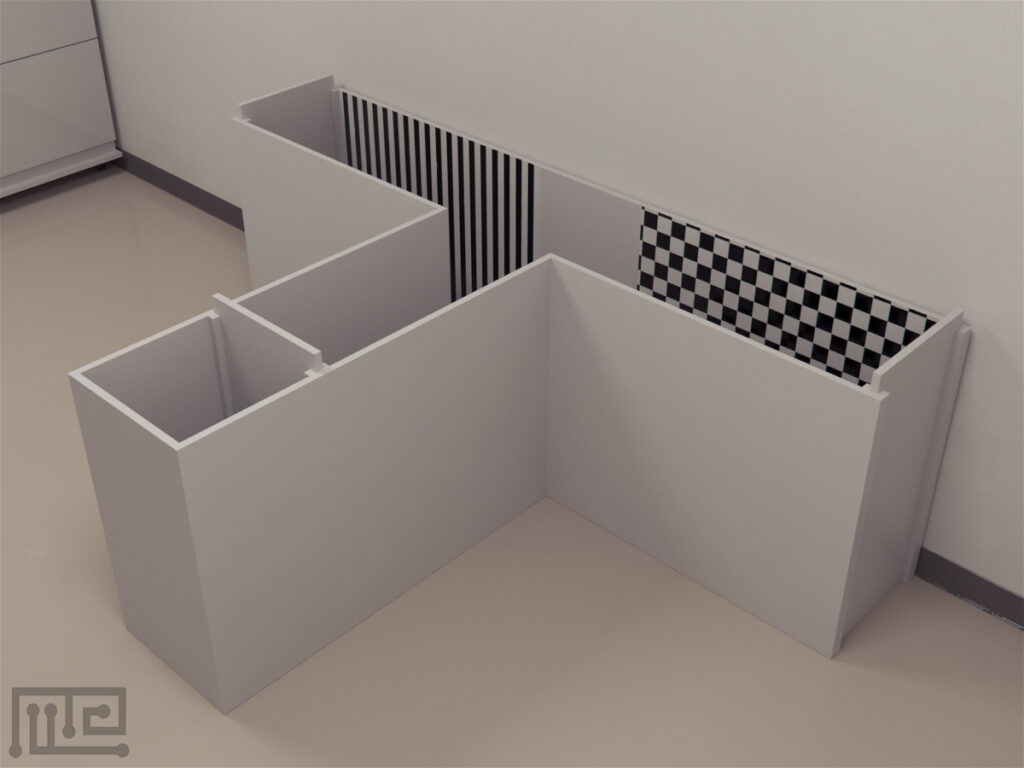The Hens T maze was used in an experiment by Dana L. M. Campbell et al. (2018), to assess spatial cognition and range use in hens.
The apparatus is a T shaped wooden maze with 3 arms of equal length. The centre arm was designated as the arm to place hens into and contained a starting box with a raiseable guillotine door and the left/right arms were choice arms. The 2 arms were visually different and lined with contrasting wallpaper (black and white zigzags or polka dots) to provide intramaze cues, but both arms contained red-coloured food reward cups placed at the arms’ end.
The hen had to approach the cup to be able to see if it contained the food reward. Each maze arm was covered with hinged wire mesh covers to prevent hen escape all extra maze cues were consistent.
Mazeengineers offers the Hens T maze.
Price & Dimensions
Hens T maze
$ 1890
+S&H- Length of maze arms: 1.20m
- Width of maze arms: 0.40m
- Height of maze: 1m
Documentation
Introduction
The hen T-maze is used to study spatial learning and memory in hens. It has a center arm that leads to two choice arms which are joined together, forming a capital ‘T’ shaped apparatus. It is an adaptation of the conventional T-maze which is used in the assessment of learning and memory in rodents.
The behavior and behavioral needs of domestic hens are influenced by several factors, including internal factors, environmental factors, and social interactions (Duncan, 1998). The two-goal arms of the hen T-maze can be set-up to provide different contexts or rewards in order to observe behaviors of hens in response to manipulation of different factors such as handling methods. These observations can then be applied to improving welfare practices in poultry. The hen T-maze can further be extended to assess learning and memory and the effects of diseases and disorders, brain lesions, and pharmacological manipulations on these capabilities. Protocols such as spontaneous alteration, wherein the arm floor color is alternated between trials, can provide insights into the cognitive capabilities of hens. Further applications of the hen T-maze can include assessment of responses to novelty, predators, and social rewards.
The hen T-maze incorporates a raiseable guillotine door near the starting end of the center arm which creates a holding area for the subject. The hen T-maze can easily be modified according to different investigatory needs by including additional guillotines doors at the entrance of the choice arms or utilizing different experimental protocols. Other T-mazes used in the evaluation of learning and memory behaviors across different species of animals include the pig T-maze, the piglet T-maze, the zebrafish bifurcating T-maze, and the ant double bifurcation T-maze.
Apparatus and Equipment
The hen T-maze consists of a center arm that leads to two choice arms that create a ‘T’ shaped maze. All the arms of the maze are equal in size and measure 1.20 m in length, 0.40 m in width, and 0.80 m in height and are covered with hinged mesh covers to prevent the subject from escaping. The center arm which also serves as the start arm has a guillotine door near the starting end which forms a holding area for the subjects. At the end of the choice arms, food rewards can be placed.
The hen T-maze can be modified by lining the choice arms with different contrasting wallpapers to make them appear visually different from each other. Additionally, guillotine doors and goal rooms can also be added in the choice arms to meet the requirements of different experimental protocols.
Training Protocol
Clean the apparatus before starting the trial and in between trials. Appropriately light the apparatus. A tracking and recording system such as the Noldus Ethovision XT can be used to assist with observations.
Habituation and Pre-training
Place the subject in the holding area. Raise the guillotine door after 30 seconds. Allow the subject to explore the maze. Let the subject visit both arms of the maze. Conduct habituation trials over the course of 4 days with each session lasting 5 minutes.
Hen T-maze task
Place the food reward in one of the choice arms. Place the subject in the holding area. Raise the guillotine door after 10 seconds. Allow the subject to explore the maze and find the reward. If the subject is immobile for 20 seconds gently encourage forward movement into the correct direction. If the subject does not enter the correct arm within 2 minutes, direct it to the correct arm using a board. Carry the subject back to the starting box after the trial ends. Conduct 1 session per subject with 5 trials per session each day. Alternate the correct choice arm in succeeding trials.
Evaluation of spatial cognition and range use in free-range hens
Campbell, Talk, Loh, Dyall, and Lee (2018) evaluated spatial cognition and range use in free-range hens. In their first experiment, thirty-one ISA Brown hens were tested to evaluate if range use patterns correlated with performance on the hen T-maze. Seventeen were outdoor-preferring hens, 8 were indoor-preferring hens, and 7 were exclusively-indoor hens. It was observed that exclusively-indoor hens showed the longest latency to reach the learning success criterion. However, no differences were observed between range access groups in the summed error rate during learning. In the second experiment, the effects of early rearing environment on the cognitive performance of 117 Hy-line Brown pullets was tested on the hen T-maze. The hens were divided into enriched and non-enriched birds of two age groups (Age group 1: 15 to 16 weeks of age; Age group 2: 17 to 18). It was observed that the non-enriched birds of age group 1 showed the longest latency to success and displayed the most errors. However, no differences were observed between treatments in age group 2. The enriched birds showed more visits to the range across the first 4 weeks, and the birds that made more errors in the task among the enriched birds tended to show fewer visits to the range. Results obtained from the two experiments showed that task performance had a relationship with the use of the outdoor range as hens that stayed indoors were slower to learn the task. For the enriched birds, maze learning rate also predicted future ranging behavior in terms of a number of daily range visits. There were no relationships between the number of errors made and the hours spent outside for either enriched or non-enriched birds. Task performance was also affected by early enrichment during rearing, but not at all tested ages.
Evaluation of the occurrence of spontaneous alternation behavior in the domestic hen
Haskell, Forkman, and Waddington (1997) investigated the occurrence of spontaneous alternation behavior in the domestic hen. Twelve adult Brown Leghorn hens (Gallus gallus domesticus) were divided into two treatment groups (handled and unhandled) and were tested on the hen T-maze for six trials per day for 9 days. Three birds from each treatment group were tested with red liners in the right arm and green in the left arm, and the other three birds received the opposite color placement. It was observed that the mean number of alternations made each day, calculated over the 9-day test period was 32%. There was no effect of treatment on the mean number of alternations over the 9-day period. The daily alternation rate did not change over the course of the experiment. The handled birds needed fewer pushes in the first days of the trial and more pushes later on. In order to gain a general measure of fear prior to maze running, the hens were subjected to a modified novel rod test. A novel rod was placed on top of the center arm on the fifth day of habituation, and the behavior of hens was analyzed. It was observed that the longer the birds took to approach the novel rod, the more alteration behavior they performed.
Evaluation of size and cage floor preferences in domestic hens
Dawkins (1978) investigated the importance of cage size and grass floors to domestic hens. Sixteen Sykes Tinted hens were evaluated in the hen T-maze with the goal arms presented with different combinations of cage set-ups. Four different types of cages were used (small and large cages with either wire or grass flooring) and the hens were tested for a combination of three choices (size test: small wire cage vs. large wire cage; floor test: small grass cage vs. large grass cage; and opposition of size and floor test: small grass cage vs. large wire cage). For each test, a bird was given a choice between the two environments presented as the alternatives on the hen T-maze. It was observed that in the floor test, the hens preferred the grass floor over the wire floor. For the size test, the hens had a preference for the larger cage than the smaller cage. Lastly, for the opposition test, the hens chose the small grass cage over the large wire one. For all tests, it was observed that the hens took a longer time to enter the cage they did not prefer.
Data Analysis
The following can be observed on the hen T-maze:
- Number of entries into the right arm
- Number of entries into the left arm
- Number of correct arm choices
- Number of incorrect arm choices
- Time spent in the right arm
- Time spent in the left arm
- Time taken to complete a trial
- Number of errors
Strengths and Limitations
Strengths
The hen T-maze is used to study spatial learning and memory in hens. It has two choice arms which can easily be modified according to different investigatory needs. Modifications can include lining the choice arms with different contrasting wallpapers (intra-maze cues) or attaching goal rooms to the choice arms ends. The maze start arm comes equipped with a guillotine door that can be used to create a start area that can help reduce stress resulting from novelty and also in the introduction of delays. The hen T-maze can also be modified through the insertion of guillotine doors. The hen T-maze can also be used to test the effects of different treatments such as brain lesions, diseases, and disorders of the nervous system, or pharmacological manipulations on learning, and memory.
Limitations
The explorative drive of subjects is highly important in the completion of the task. The behavior of subjects to perform the task may be influenced by hunger and motivation to find food. Unnecessary stimuli may affect task performance. Stress may interfere with task performance. Factors such as age, gender, and strain of the subjects may affect task behavior.
Summary
- The hen T-maze is used to study spatial learning and memory in hens.
- The hen T-maze has a center arm that leads to two choice arms which form a capital ‘T’ shaped apparatus.
- The choice arms of the maze can be modified by lining them with different contrasting wallpapers or adding goal rooms to the ends.
- The hen T-maze has a guillotine door near the starting end of the center arm which forms a holding area for the subjects before starting trials.
- The hen T-maze can be used in the observation of hens behaviors in response to exposure to different treatments such as environmental conditions and handling methods.
References
- Campbell, D., Talk, A., Loh, Z., Dyall, T., & Lee, C. (2018). Spatial cognition and range use in free-range laying hens. Animals, 8(2), 26. doi: 10.3390/ani8020026
- Dawkins, M. (1978). Welfare and the Structure of a Battery Cage : Size and Cage Floor Preferences in Domestic Hens. British Veterinary Journal, 134(5), 469–475. doi:10.1016/s0007-1935(17)33389-4
- Duncan, I. (1998). Behavior and behavioral needs. Poultry Science, 77(12), 1766–1772. doi:10.1093/ps/77.12.1766
- Haskell, M., Forkman, B., & Waddington, D. (1998). An investigation into the occurrence of spontaneous alternation behaviour in the domestic hen. Behavioural Processes, 43(1), 43–51. doi:10.1016/s0376-6357(97)00085-5




